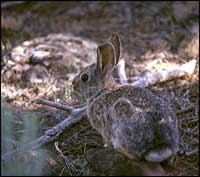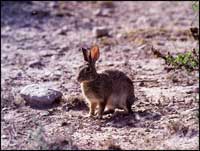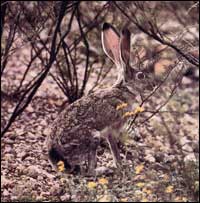Rabbits and Hares
Alike yet different, is a good way to describe the eastern cottontail, the swamp rabbit, and the California jackrabbit. The first two are true rabbits, but the jackrabbit is not a rabbit at all; it's a hare. Since all three live within our borders, let's take a closer look at them.
One of the differences between hares and rabbits is the type of nest they build, and this is determined by the condition of their young at birth. Since a young jackrabbit is born with its eyes open, its body fully furred, and with the ability to hop around only moments after its birth, it has no need for an elaborate nest. In fact, the jackrabbit mother builds no nest at all. A shallow depression in the ground or vegetation is adequate, and the births of young from the same litter may occur some distance from each other. The mature female can have two to four litters with four to six young each year; however, the average number of young produced by each female is ten per year.

Cottontails are born naked, blind, and completely dependent upon their mother's care.
True rabbits deliver their young in more sheltered nests. The eastern cottontail's nest is a saucerlike depression three or four inches deep and about eight inches across. It is lined with mouthfuls of soft, dead grass mixed with hair from the mother's breast. A covering of grass and hair is used to hide the nest and keep the young warm and dry. At birth young cottontails are naked, blind, and completely dependent on their mother's care. Since conditions are harsh and predators many, less than half of the young will survive to leave the nest and many others will be eliminated before reaching maturity. Their 85-percent mortality rate is offset by their reproduction potential. Cottontails may have four to five litters each year with as many as eight young per litter. However, the average litter size is four.
Growth of the newborn cotton-tails is rapid. In six to eight days the eyes and ears begin to open, and the young can move about and squeal. By the end of the second week they weigh a little more than three ounces, have a fully developed fur coat, and are ready to leave the nest. In another week or so they are completely weaned, and since the mother probably is ready to give birth to another litter, they must begin to fend for themselves. In four or five months the young cannot be distinguished from adults.
The swamp rabbit locates its fur-lined nest in a hollow log or stump when possible. If no such shelter is available, the nest is constructed in a surface depression like that of a cottontail. Two or more litters per year, with two to three young in each, are usual. Newborn swamp rabbits have characteristics of both rabbits and hares. They are fully furred like the jackrabbit, but their eyes are closed like those of the eastern cottontail. When their eyes open in two or three days, the young are able to leave the nest and soon are on their own.

Although it enters more open areas to feed, the cottontail seldom strays far from the protection of brushy cover.
Ranges of the three species overlap in some areas of the state, but each has its own preferred habitat where it will most likely be found. The jackrabbit prefers hot, dry scrub-land and is seldom found in forested areas. It usually spends the hottest part of the day dozing at the base of a shrub or in a clump of tall grass and begins foraging at twilight. During winter the same shrub or tall clump of grass may offer it protection from cold winds.
The swamp rabbit can be found in poorly drained river bottoms among the tangled shrubs, trees, and vines or in the coastal marshes. Its preference for cane thickets on the coast has given it the local name of "cane cutter." It is well adapted to a semi-aquatic habitat and often is found in the water, crossing rivers and streams or hiding beneath overhanging vegetation.
Although the eastern cottontail occasionally shares the poorly drained river bottomlands of the swamp rabbit, it is more commonly found in the brush along well-drained streamsides. Unlike the jackrabbit, which prefers a more open habitat, the cottontail chooses dense brush. It seldom strays far from the protection of brushy cover even when it enters more open areas to feed.
The eastern cottontail is the smallest of the three species, weighing two to three pounds. Next is the swamp rabbit, which weighs three to six pounds. The largest is the jackrabbit, weighing four to eight pounds. The length of the ears follows the same pattern – eastern cottontail, 52 mm.; swamp rabbit, 70 mm.; and jackrabbit, 125 mm.
Texas also has two other cottontail species – the Davis Mountains cottontail, and the Audubon cottontail. The Davis Mountains cottontail inhabits the piñon-oak-juniper woodlands in the Chisos, Chinati, Davis, and Guadalupe mountains in Brewster, Presidio, Jeff Davis, and Culberson counties. It also ranges into the pine-fir forests at higher elevations. Body weight varies from three to four pounds, and the ears are 71 mm. long, almost 20 mm. longer than those of the eastern cottontail.
The Audubon cottontail inhabits the western half of the state and can be found in a variety of habitats. It manages to make itself at home in grasslands, cactus deserts, or brushlands and can be found in thickets of catclaw, mesquite, allthorn, and other desert shrubs. In some areas this rabbit is known as the "prairie dog rabbit" because of its association with prairie dog towns. It weighs one and a half pounds and has ears 60 mm. long.

The jackrabbit is not a rabbit at all, but a hare.
The jackrabbit's reputation for speed is well earned, and individuals have been clocked at speeds up to forty-five miles per hour. Predators usually must rely on strategy to outwit or outmaneuver a healthy, mature jackrabbit. Cottontails rarely exceed eighteen miles per hour, but an illusion of greater speed is created by the zigzag pattern they usually run. More often than not, the cottontail will "freeze" motionless, relying on its ability to blend into its surroundings to escape detection rather than running.
Wide-spreading toes allow the swamp rabbit to get good traction as it runs on slippery ground, and definite toe prints are visible in its tracks. When it runs, its large hind feet loudly thump the ground. This rabbit usually runs a circular pattern when being chased and may take refuge in a rushing river as quickly as a dense thicket. It is said that the swamp rabbit can outdistance a Labrador retriever in the water.
Contrary to what most people think, cottontails are not sociable creatures. They tend to scatter over their range, and a population density of one cottontail per four and a half acres is common. Swamp rabbits establish a very definite range and are reluctant to leave it even when being pursued by a predator. A population density of one swamp rabbit per seven acres is normal. Their preference for areas with sparse vegetation tends to concentrate jackrabbits on poor, overgrazed rangeland. Periodic population explosions, which seem to peak every seven years, can produce densities of four hundred jackrabbits per square mile. Such high concentrations are a good indication the land is being overgrazed by livestock. When conditions are normal, jackrabbits are not numerous enough to damage ordinary pasture lands.
Ilo
Hiller
1990 – Rabbits and Hares: Introducing Mammals
to Young Naturalists. The Louise
Lindsey Merrick Texas Environment
Series, No. 10, pp. 39-42.
Texas A&M University
Press, College Station.